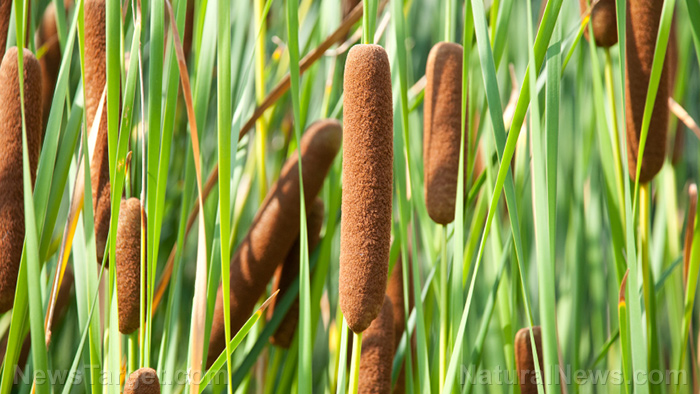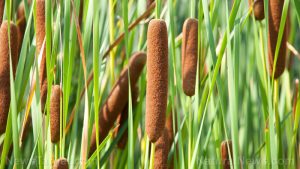
Bulrush – sources, health benefits, nutrients, uses and constituents at NaturalPedia.com
Thursday, August 03, 2017 by Frances Bloomfield
http://www.naturalpedia.com/bulrush-sources-health-benefits-nutrients-uses-and-constituents-at-naturalpedia-com.html

Bulrushes, also known as cattails, are wetland plants that are a common sight in large marshes and ponds all over the United States. They are easily identifiable by their large, cylindrical seed heads and long, flat leaves. There are several types of bulrushes, with the two most widely distributed ones being the broad leaved and narrow leaved varieties. Bulrushes can be consumed and have been for hundreds of years. The leaves, sheaths, and rhizomes can be eaten in certain ways.

List of known nutrients
Bulrushes contain a surprisingly diverse abundance of nutrients, most notably:
- Bioflavonoids
- Calcium
- Carotenoids
- Dietary fiber
- Iron
- Magnesium
- Manganese
- Phosphorus
- Potassium
- Vitamin B6
- Vitamin C
- Vitamin K
Note: bulrushes may contain a negligible amount of saturated fats, but they’re also quite high in sodium, calories, and carbohydrates. This makes them a decent food option for underweight individuals who wish to gain weight safely.
Medicinal uses for bulrush
Bulrush is known to be useful in remedying or preventing:
- Anemia
- Atherosclerosis
- Boils
- Cancer
- Constipation
- Diabetes
- Heavy bleeding
- Hypertension
- Inflammation
- Insect bites
- Sores
The many parts of bulrushes have coagulant qualities that make them highly effective in slowing down blood flow. Apart from lessening the flow of blood that comes from wounds, this means that bulrushes can lessen the severity of menstrual bleeding as well. The coagulant qualities are also helpful in preventing anemia.
The jelly-like substance taken from young bulrush leaves can act as a potent analgesic that, when applied topically, can relieve inflammation and pain.
That same jelly is a natural antiseptic too, so applying it to wounds can keep pathogens and microbes from entering the body.
Bulrushes have a unique composition of vitamin C, bioflavonoids, and carotenoids, all of which contribute to the decreased risk of atherosclerosis by decreasing the levels of low-density lipoprotein (LDL) or bad cholesterol.
Body systems supported by bulrush
Topically applying bulrush is good for the skin. Its wealth of organic compounds and nutrients have a positive impact that include decreasing the appearance of scars, healing sores and boils, and even soothing insect bites. Although the jelly is considered to be the best for insect bites, bulrush flour is just as effective thanks to its anti-inflammatory effect, which minimizes the pain of affected areas.
The dietary fiber in bulrush is good for maintaining a healthy digestive system. This fiber content not only keeps the digestion process smooth, but it also encourages waste movement and counters the absorption of cholesterol.
By lowering the risk of hypertension and atherosclerosis, bulrushes can be used or taken to keep the heart strong and healthy.
Ways to use bulrush
All parts of the bulrush plant can be eaten, but it’s the rhizome pollen that is turned into bulrush flour. This flour can then be mixed into all kinds of recipes, such as pasta, muffins, pancakes, and bread.
The roots, meanwhile, can be eaten raw or cooked — usually boiled — then eaten like potatoes. Powdered bulrush root can be used to thicken soups and add protein to cereal flours.
Even bulrush seeds are edible, and do well roasted or turned into cooking oil.
Where to learn more
- Cattail: Learn how to harvest and utilize this wild aquatic plant during the best and worst of times
- Six edible plants that will help you survive in the wild
- These incredible plants were used by Native Americans to cure illness
- Wild edible plants and natural solutions for diabetes
Summary
Bulrushes have a number of surprising health benefits. In addition to treating insect bites, boils, and wounds, they can maintain the proper operation of the digestive system, and protect the heart and skin. All parts of the bulrush plant can be used for culinary and medicinal applications, in part thanks to their average coagulant and antiseptic qualities.
Sources include:
Cattails.info
NutritionData.Self.com
HealthBenefitsTimes.com
OrganicFacts.net
Honest-Food.net
Tagged Under: Tags: Bulrush





